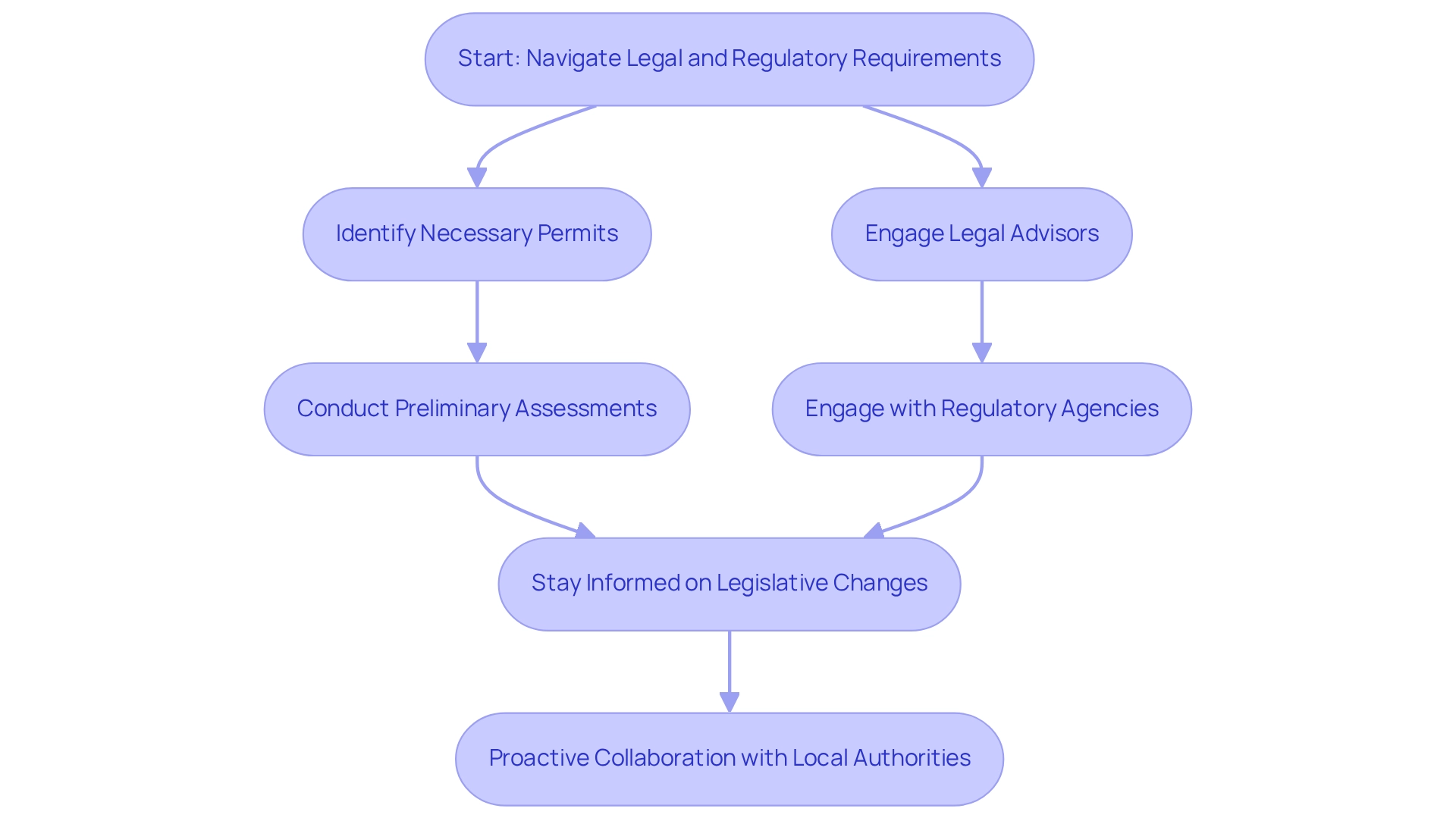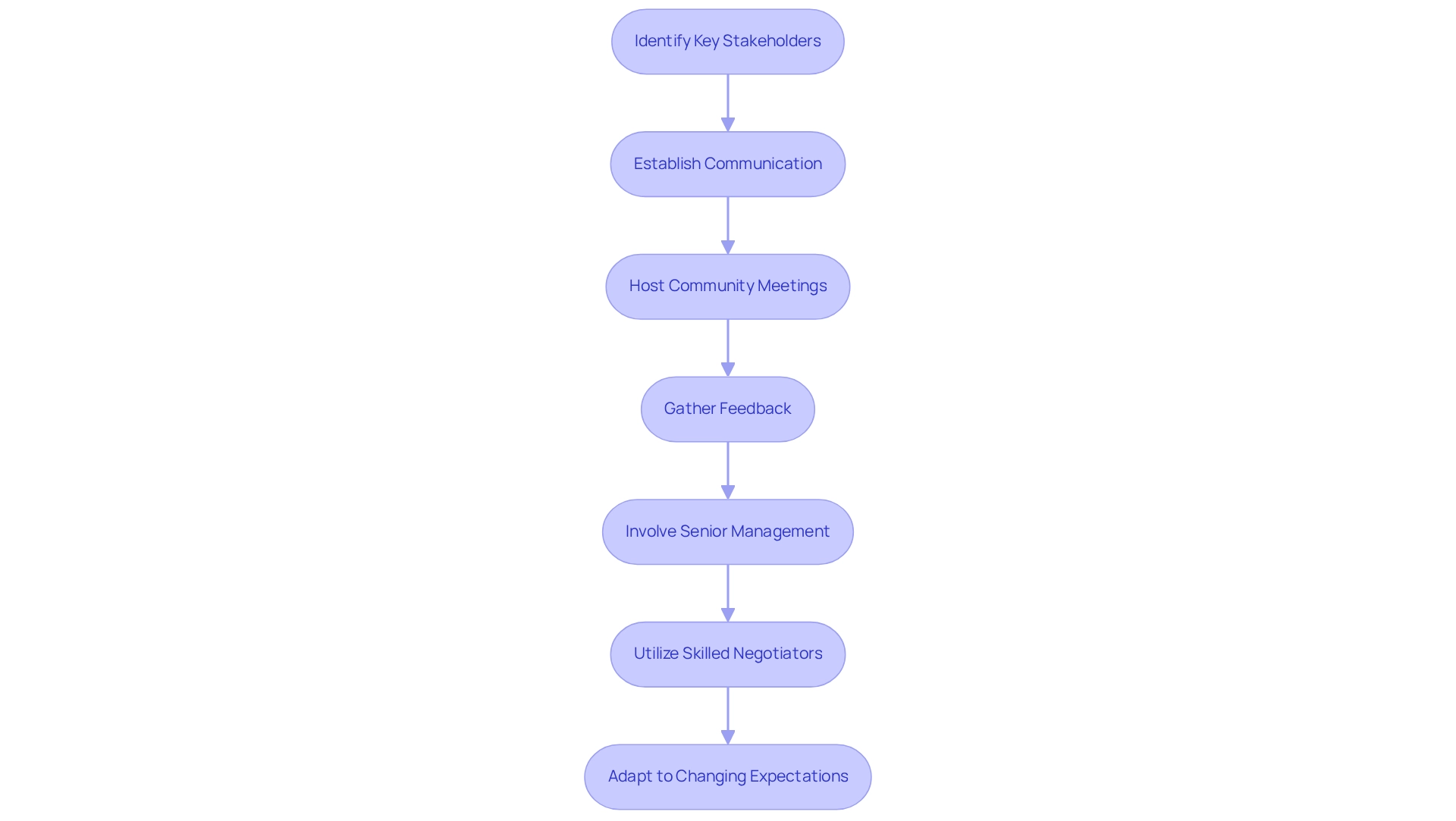Overview
This article presents essential strategic planning insights for effective renewable energy zoning, particularly for wind farms. It underscores the critical role of stakeholder engagement, adept legal navigation, and the utilization of advanced technologies. By providing compelling case studies and examples, the article illustrates how:
- Comprehensive planning
- Early involvement of local authorities
- Application of GIS and AI tools
can streamline processes, alleviate public concerns, and significantly boost project success rates.
Introduction
In the pursuit of sustainable energy solutions, the strategic planning and development of renewable energy projects are essential. As the global community increasingly embraces wind energy, grasping the complexities of zoning, legal requirements, stakeholder engagement, and technological integration is vital for achieving success.
This article explores the fundamental elements of effective renewable energy zoning. It covers:
- Assessing potential sites
- Navigating regulatory landscapes
- Fostering community support
- Leveraging advanced technology
By analyzing case studies and expert insights, this piece illuminates pathways to streamline project development and enhance collaboration among stakeholders, ultimately paving the way for a greener future.
Establish Strategic Planning for Renewable Energy Zoning
Efficient strategic planning for renewable energy zoning for wind farms begins with a thorough evaluation of potential locations, focusing on land use patterns, environmental impacts, and local requirements. GIS mapping tools are essential in this process, offering spatial analysis of air resources, proximity to existing infrastructure, and identifying potential environmental constraints. Timely engagement with local authorities is vital to align goals with public interests and regulatory standards.
A significant case study from Texas illustrates this approach: local authorities collaborated with developers to implement renewable energy zoning for wind farms, which not only facilitated wind farm development but also addressed public concerns regarding land use and aesthetics. This proactive strategy streamlined the permitting process and garnered public support, highlighting the importance of incorporating stakeholder perspectives in renewable energy zoning for wind farms.
Furthermore, the recent success of Maine Audubon in securing a pitch competition emphasizes the value of local involvement in renewable initiatives. As Julia Wu, Co-Founder & CEO of Spark AI, remarked, "The bottlenecks in renewables deployment are often caused by paperwork and regulatory complexity," stressing the necessity for early engagement with local governments to effectively navigate these challenges.
Additionally, the forthcoming virtual event focused on legislative and permitting factors for battery energy storage initiatives will provide timely insights into current trends and challenges related to renewable energy zoning for wind farms. It is imperative for Directors of Land Acquisition to recognize common pitfalls in strategic planning, such as overlooking community input or failing to address regulatory hurdles, to ensure successful project outcomes.
Navigate Legal and Regulatory Requirements
Navigating the legal and regulatory landscape for renewable energy zoning for wind farms presents significant challenges that demand a comprehensive understanding of federal, state, and local laws. Developers must identify all necessary permits and approvals, including environmental assessments and land use permits. Engaging legal advisors with expertise in renewable resources law is essential for effectively managing these complexities.
In California, for example, the California Environmental Quality Act (CEQA) has undergone updates in 2025, requiring thorough environmental reviews that can considerably extend project timelines. To mitigate potential delays, developers should conduct preliminary assessments and proactively engage with regulatory agencies early in the process. Staying informed about legislative changes, particularly those affecting renewable energy zoning for wind farms, is crucial for adapting strategies effectively.
The placement of energy facilities is increasingly scrutinized due to environmental concerns, making it imperative for developers to navigate these challenges meticulously. In 2022, turbines accounted for approximately 10.3% of total U.S. utility-scale electricity production, underscoring the growing importance of effective permitting procedures in this sector. A notable case in Oregon illustrated the benefits of proactive collaboration with local authorities, leading to expedited permitting for renewable energy zoning for wind farms. This example highlights the advantages of strategic legal navigation, which can significantly enhance timelines and success rates in the competitive renewable energy landscape.
As Ángel S. Fernández-Bou, a Senior Climate Scientist, emphasizes, understanding the regulatory framework is vital to avoid potential pitfalls in development.

Engage Stakeholders and Manage Negotiations
Engaging stakeholders early and effectively is crucial for the success of renewable energy zoning for wind farm projects. Developers must identify key stakeholders, including local populations, environmental organizations, and government agencies, and establish open lines of communication. Hosting community meetings and informational sessions not only addresses concerns but also gathers valuable feedback.
For instance, a wind initiative in New York successfully mitigated opposition by actively involving local residents in the planning process, allowing them to voice their concerns and contribute to the design. This strategy aligns with findings that organizations using formal management techniques achieve their objectives 73% of the time, compared to just 58% for those that do not.
Additionally, it is essential to recognize that 33% of initiatives fail due to insufficient involvement from senior management, underscoring the necessity for their active participation in stakeholder engagement efforts. Furthermore, utilizing skilled negotiators can facilitate discussions with landowners and other stakeholders, ensuring that agreements are mutually advantageous.
A significant case study from Colorado illustrates how open discussions resulted in a land lease agreement that satisfied both the developer's needs and the landowner's interests, ultimately enhancing feasibility. This case highlights the importance of aligning objectives with stakeholder expectations, as nearly half of strategic initiatives fail due to misalignment.
Moreover, as customer and stakeholder expectations can evolve during the course of project completion, developers must remain adaptable and responsive to these shifts. By emphasizing public engagement and efficient negotiation tactics in renewable energy zoning for wind farms, developers can significantly enhance the likelihood of success and foster positive relationships with stakeholders.
As Silicon Ranch emphasizes, leveraging high visibility and communication strategies can further promote community support for renewable energy projects.

Leverage Technology and Data for Efficient Land Acquisition
The integration of technology, particularly GIS and AI-driven land acquisition software, is essential for enhancing the effectiveness of land acquisition processes in renewable energy zoning for wind farms. These sophisticated tools empower developers to analyze extensive datasets, facilitating the identification of optimal sites based on wind potential, land use compatibility, and environmental constraints. A notable example can be found in a recent initiative in Illinois, where GIS mapping was effectively utilized to evaluate multiple sites simultaneously, enabling swift, data-driven decision-making.
Furthermore, the establishment of a centralized database for landowner interactions streamlines negotiations and guarantees thorough documentation of all communications. This approach not only promotes transparency but also nurtures trust with landowners. A significant case in Minnesota exemplifies this strategy, showcasing how technology enabled prompt land acquisition, ensuring that the initiative adhered to critical deadlines and budget constraints.
Statistical evidence supports the efficacy of GIS in site selection, with a consistency ratio (CR) of less than or equal to 0.10 indicating acceptable reliability in decision-making processes. Moreover, the multi-output random forest model has proven to outperform other models in terms of accuracy and computational efficiency, highlighting the advantages of leveraging advanced technology in land acquisition.
As emphasized by Ángel S. Fernández-Bou, a Senior Climate Scientist, "FIRO to avoid water FOMO: how not to waste a single drop in reservoir operations in California," there is a pressing need for efficient resource management within renewable initiatives. Additionally, the integration of AI for dynamic optimization of wind turbines not only enhances land acquisition strategies but also improves operational efficiency, leading to increased power generation.
While the advantages of utilizing GIS and AI are significant, it is crucial to remain vigilant against common pitfalls, such as data misinterpretation or excessive reliance on technology without human oversight. As the renewable energy sector continues to evolve, the implementation of renewable energy zoning for wind farms will be vital for optimizing land acquisition strategies and ensuring project success.
Conclusion
Effective strategic planning, navigating legal frameworks, engaging stakeholders, and leveraging technology are the cornerstones of successful renewable energy zoning. A thorough assessment of potential sites, utilizing GIS mapping, allows developers to align their projects with community needs and environmental considerations. Early engagement with local governments ensures that regulatory requirements are met, ultimately streamlining the permitting process. The highlighted case studies demonstrate how proactive strategies can mitigate opposition and foster community support, which is crucial for project viability.
Understanding the legal landscape is equally vital, as developers must stay informed about regulatory changes and secure necessary permits. By engaging legal counsel and maintaining open lines of communication with regulatory agencies, potential delays can be minimized, enhancing project timelines. The examples from California and Oregon illustrate the importance of strategic legal navigation in the competitive renewable energy sector.
Stakeholder engagement cannot be overlooked, as it significantly influences project outcomes. By involving local communities and key stakeholders early in the process, developers can address concerns and build trust. Successful negotiations lead to mutually beneficial agreements, contributing to project success. The integration of advanced technology, such as GIS and AI, further enhances efficiency in land acquisition, enabling data-driven decision-making.
In conclusion, the path to successful renewable energy projects is paved with strategic planning, legal acumen, stakeholder collaboration, and technological innovation. As the demand for sustainable energy solutions grows, embracing these fundamental elements will be essential for overcoming challenges and achieving a greener future. By prioritizing these strategies, the renewable energy sector can continue to thrive and make significant contributions to global sustainability efforts.
Frequently Asked Questions
What is the first step in efficient strategic planning for renewable energy zoning for wind farms?
The first step is a thorough evaluation of potential locations, focusing on land use patterns, environmental impacts, and local requirements.
How do GIS mapping tools contribute to the planning process for wind farms?
GIS mapping tools offer spatial analysis of air resources, proximity to existing infrastructure, and help identify potential environmental constraints.
Why is timely engagement with local authorities important in renewable energy zoning?
Timely engagement with local authorities is vital to align goals with public interests and regulatory standards, facilitating a smoother planning and permitting process.
Can you provide an example of successful renewable energy zoning?
A significant case study from Texas shows that local authorities collaborated with developers to implement renewable energy zoning for wind farms, addressing public concerns and streamlining the permitting process.
What did Julia Wu from Spark AI emphasize regarding renewable deployment challenges?
Julia Wu emphasized that bottlenecks in renewables deployment are often caused by paperwork and regulatory complexity, highlighting the necessity for early engagement with local governments.
What upcoming event is mentioned that relates to renewable energy zoning?
A forthcoming virtual event focused on legislative and permitting factors for battery energy storage initiatives will provide insights into current trends and challenges related to renewable energy zoning for wind farms.
What common pitfalls should Directors of Land Acquisition recognize in strategic planning?
Directors should recognize common pitfalls such as overlooking community input and failing to address regulatory hurdles to ensure successful project outcomes.
List of Sources
- Establish Strategic Planning for Renewable Energy Zoning
- Announcing the Renewable Energy Siting Tool - Maine Audubon (https://maineaudubon.org/news/announcing-the-renewable-energy-siting-tool)
- euci.com (https://euci.com/event_post/renewable-energy-permitting)
- Navigate Legal and Regulatory Requirements
- Siting and Permitting Wind Projects (https://stoel.com/insights/reports/the-law-of-wind/siting-and-permitting-wind-projects)
- blog.ucs.org (https://blog.ucs.org/john-rogers/offshore-wind-quotes)
- Electricity generation from wind - U.S. Energy Information Administration (EIA) (https://eia.gov/energyexplained/wind/electricity-generation-from-wind.php)
- Wind Power Facts and Statistics | ACP (https://cleanpower.org/facts/wind-power)
- State and Local Permitting Restrictions on Wind Energy Development - R Street Institute (https://rstreet.org/commentary/state-and-local-permitting-restrictions-on-wind-energy-development)
- Engage Stakeholders and Manage Negotiations
- Project Management Statistics 2024: New Trends | TeamStage (https://teamstage.io/project-management-statistics)
- Houston Solar Project – Silicon Ranch (https://siliconranch.com/us-solar/ga/houston-solar-project)
- Leverage Technology and Data for Efficient Land Acquisition
- Application of Artificial Intelligence in Wind Power Systems (https://mdpi.com/2076-3417/15/5/2443)
- blog.ucs.org (https://blog.ucs.org/john-rogers/offshore-wind-quotes)
- sciencedirect.com (https://sciencedirect.com/science/article/pii/S2666519025000585)
- 60 Quotes About the Future of Renewable Energy (https://deliberatedirections.com/renewable-energy-quotes)




